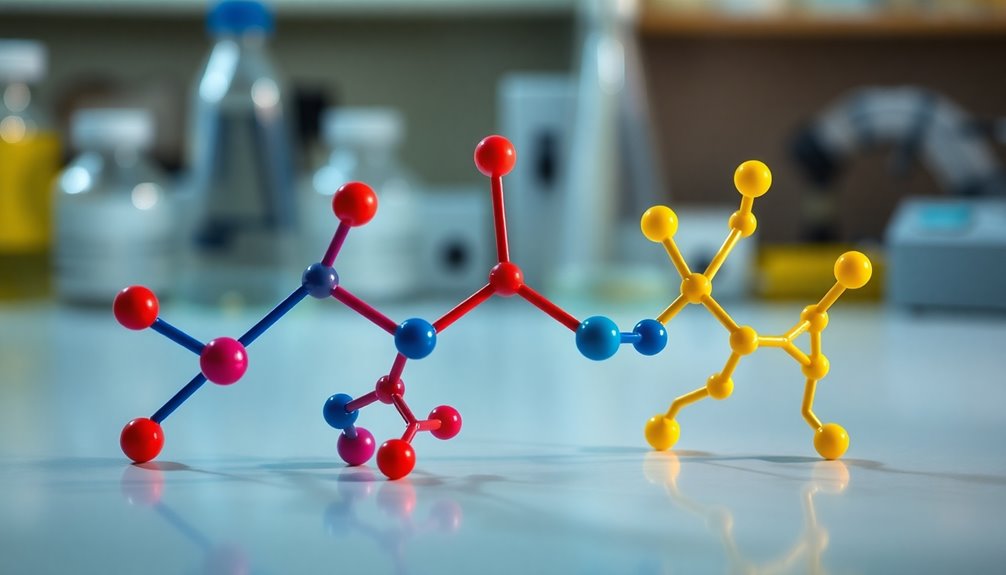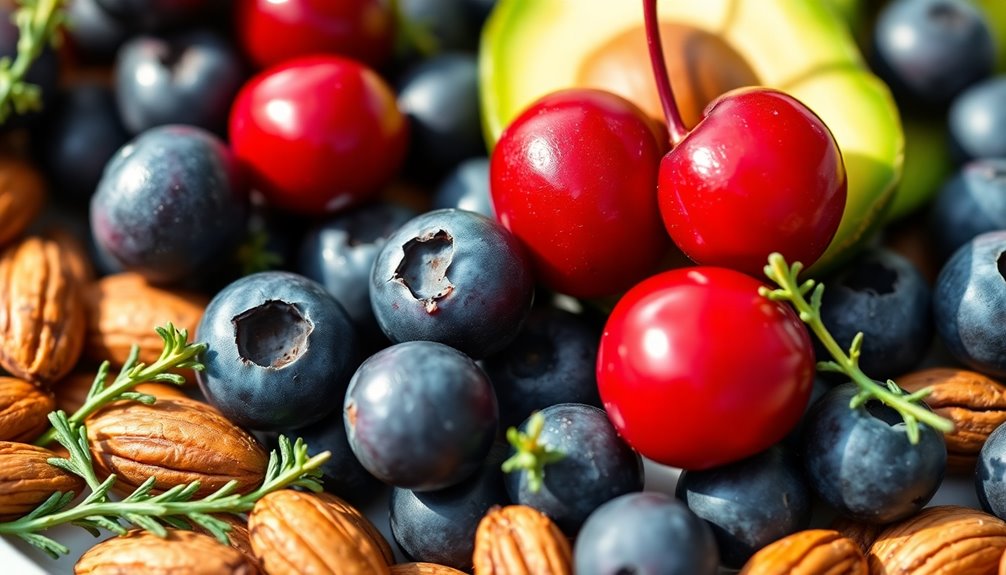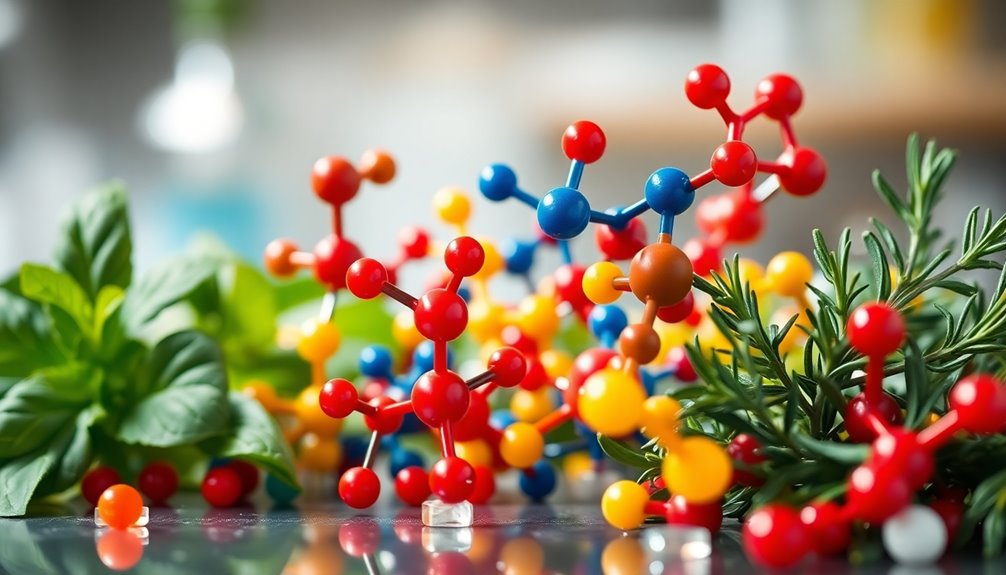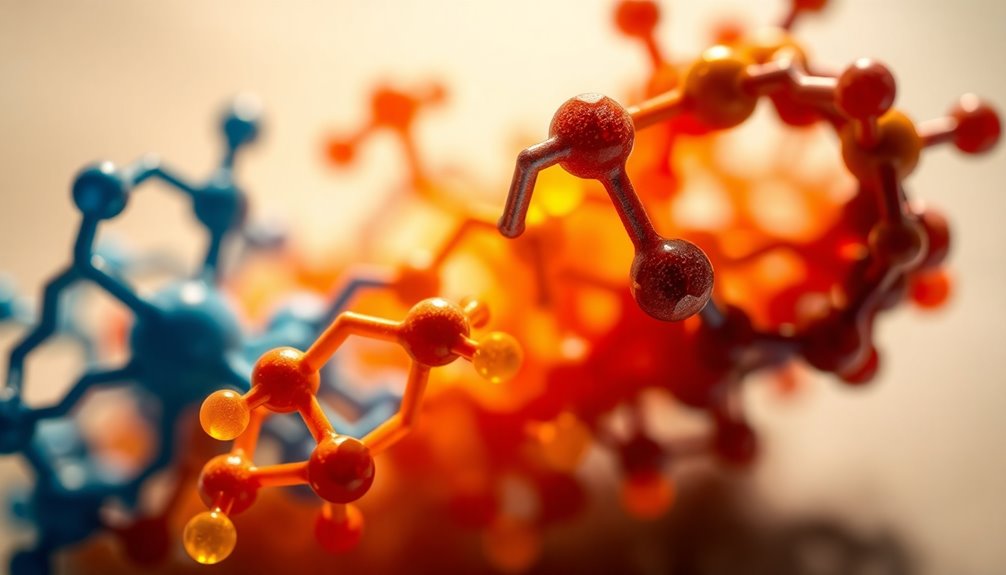Aromatic amino acids include phenylalanine, tyrosine, and tryptophan, all essential for your health. Phenylalanine and tryptophan are required, meaning you need to get them from your diet. Tyrosine is semi-essential, as your body can make it from phenylalanine. These amino acids play a critical role in protein synthesis and influence various biological functions. They also help in producing important neurotransmitters like dopamine and serotonin, impacting your mood and sleep. You can find them in high-protein foods such as meat, fish, and soy. There's much more to explore about their roles and sources.
Key Takeaways
- Aromatic amino acids (AAAs) include phenylalanine, tyrosine, and tryptophan, essential for protein synthesis and various biological functions.
- Phenylalanine and tryptophan are essential amino acids, while tyrosine is semi-essential, synthesized from phenylalanine.
- AAAs possess a benzene ring, enabling them to absorb UV light, important for protein detection in studies.
- Tyrosine is a precursor for neurotransmitters like dopamine, whereas tryptophan is vital for serotonin and melatonin synthesis.
- Dietary sources of AAAs include meat, fish, dairy, legumes, nuts, and seeds, ensuring adequate intake for health.
Definition of Aromatic Amino Acids

Aromatic amino acids (AAAs) are essential building blocks of proteins that feature an aromatic ring structure, including phenylalanine, tyrosine, and tryptophan.
You need to know that phenylalanine and tryptophan are classified as essential amino acids, meaning your body can't synthesize them, so you must obtain them through your diet.
Tyrosine, on the other hand, is semi-essential since it can be produced from phenylalanine.
These aromatic amino acids play pivotal roles in protein synthesis, contributing to the structure, stability, and interactions of proteins, especially in globular proteins.
They also have the unique ability to absorb UV light, with tryptophan peaking at 280 nm and tyrosine at 274 nm, highlighting their importance in various metabolic processes, including the shikimate pathway.
Chemical Structure

When examining the chemical structure of aromatic amino acids, you'll notice they possess a unique cyclic framework that includes a benzene ring.
The common aromatic amino acids—phenylalanine, tyrosine, and tryptophan—each feature a distinct R group attached to the central carbon atom. This central carbon is tetrahedrally bonded to four different components: a carboxylic acid group (-COOH), an amino group (-NH2), a hydrogen atom, and the variable R group.
The presence of the benzene ring not only gives these amino acids their aromatic properties but also allows them to absorb UV light above 250 nm. This characteristic makes them particularly useful in protein studies, as their unique structures contribute to their detection and analysis.
Biological Importance

The unique structures of aromatic amino acids not only contribute to their chemical properties but also underscore their biological significance.
These amino acids—phenylalanine, tyrosine, and tryptophan—are essential for protein synthesis and play vital roles in various biological functions.
Tyrosine acts as a precursor for neurotransmitters like dopamine and norepinephrine, which regulate mood and cognitive functions.
Tryptophan is essential for synthesizing serotonin and melatonin, influencing your sleep patterns and emotional well-being. In addition, kynurenic acid, derived from tryptophan, supports neuronal health.
Aromatic amino acids also participate in metabolic pathways, aiding in hormone synthesis and secondary metabolites essential for growth and defense in both plants and animals.
Deficiencies can lead to significant health issues, highlighting their importance.
Dietary Sources

When it comes to aromatic amino acids, you'll find plenty of options in both animal and plant-based foods.
High-protein sources like meat, fish, dairy, and eggs are rich in these essential nutrients, while soy products, legumes, nuts, and seeds cater to those following vegetarian or vegan diets. If you're considering supplementation, there are also options available to help you meet your needs. Additionally, incorporating high-protein sources into your diet can significantly enhance your intake of these amino acids.
Animal-Based Sources
If you're looking to boost your intake of aromatic amino acids, animal-based sources are among the best options available. These protein-rich foods provide essential amino acids like phenylalanine, tryptophan, and tyrosine. Chicken and turkey are fantastic for tryptophan, while beef and pork are excellent sources of phenylalanine.
Here's a quick look at some top animal-based sources:
| Food | Aromatic Amino Acids |
|---|---|
| Chicken | Tryptophan |
| Salmon | Phenylalanine, Omega-3 |
| Cheese | Tyrosine |
Including these foods in your diet can greatly enhance your dietary intake of these crucial amino acids, supporting your overall health and well-being. Moreover, merchant services can facilitate the purchase of high-quality animal-based products conveniently. Don't miss out!
Plant-Based Sources
While many people associate protein with animal products, a variety of plant-based sources can also provide essential aromatic amino acids. Foods like soy products, legumes, nuts, and seeds are rich in phenylalanine, tyrosine, and tryptophan.
For instance, tryptophan is particularly abundant in pumpkin seeds, sesame seeds, and soybeans, making them excellent choices for a vegetarian or vegan diet. You can find phenylalanine in high concentrations in lentils, chickpeas, and peanuts, which boost your protein intake.
Additionally, tyrosine can be sourced from avocados, bananas, and spinach, further enhancing your aromatic amino acid profile. It's vital for anyone on a vegetarian or vegan diet to combine various plant sources to guarantee they get all essential amino acids.
Supplementation Options
Supplementing your diet with aromatic amino acids can be beneficial, especially if you have dietary restrictions or specific health conditions. Aromatic amino acids like phenylalanine, tyrosine, and tryptophan are crucial for various bodily functions.
If you're struggling to get these through your diet, particularly with conditions like phenylketonuria, supplementation might be necessary. Foods such as meat, fish, and dairy are rich in these amino acids, while plant-based sources like soy, legumes, and nuts can also help.
Tryptophan, for instance, plays a significant role in serotonin production, impacting your mood. To guarantee you're meeting your needs, focus on a balanced diet, and consider supplements if you can't access adequate dietary sources.
Health Implications

Aromatic amino acids are essential for maintaining overall health, as deficiencies can lead to significant issues such as mood disorders and cognitive impairments. Tryptophan, for example, is vital because it serves as a precursor for serotonin, directly impacting mood regulation and mental health. However, too much can trigger toxicity, resulting in hypertension and metabolic disorders. Elevated levels of metabolites like phenylacetylglutamine (PAG) can increase risks for obesity and diabetes. Additionally, imidazole propionate, derived from histidine, has been connected to impaired insulin signaling.
| Issue | Impact |
|---|---|
| Deficiencies | Mood disorders, cognitive impairments |
| Elevated metabolites | Obesity, diabetes, chronic kidney dysfunction |
| Tryptophan | Serotonin production, mood regulation |
| Excess intake | Toxicity, metabolic disorders |
Synthesis and Metabolism

Although the synthesis and metabolism of aromatic amino acids (AAAs) can seem complex, understanding their pathways reveals how they contribute to overall health.
You'll find that phenylalanine, tyrosine, and tryptophan are synthesized from phosphoenolpyruvate and erythrose 4-phosphate via the shikimate pathway in plants and microorganisms.
In mammals, tyrosine is produced from phenylalanine through hydroxylation, making phenylalanine essential while considering tyrosine semi-essential. The biosynthesis involves common precursors from the pentose phosphate pathway, linking AAAs to broader metabolic networks.
Additionally, gut microbiota play an important role in AAA metabolism, generating metabolites like indole and phenol, which can considerably impact health.
Elevated levels of aromatic amino acid metabolites, such as indoxyl sulfate, are linked to chronic diseases like kidney disease and cardiovascular conditions.
Frequently Asked Questions
What Are Aromatic Amino Acids?
Aromatic amino acids are essential for your body's functions. They include phenylalanine, tyrosine, and tryptophan, each featuring an aromatic ring structure.
You get phenylalanine and tryptophan from your diet, while your body can convert phenylalanine into tyrosine.
These amino acids play significant roles in protein synthesis and act as precursors for neurotransmitters like serotonin and dopamine, influencing your mood and metabolism.
Adequate intake is important for maintaining overall health.
Why Is Histidine Not an Aromatic Amino Acid?
Histidine's unique characteristics keep it from joining the aromatic amino acid club.
You'll notice it lacks a fully conjugated aromatic ring, unlike phenylalanine, tyrosine, and tryptophan. While those absorb UV light, histidine doesn't contribute at 280 nm.
Its imidazole group allows it to shine in biochemical reactions, acting as a proton donor or acceptor at physiological pH.
This distinct profile makes histidine semi-essential, but not aromatic.
What Are the 9 Essential Amino Acids?
You need to know the nine essential amino acids your body can't produce on its own.
They're histidine, isoleucine, leucine, lysine, methionine, phenylalanine, threonine, tryptophan, and valine. Each plays a vital role in your body, from supporting muscle growth to aiding in hormone production.
You must obtain these amino acids through your diet to maintain overall health and well-being. Make sure you include a variety of protein sources in your meals!
How Do You Know if an Amino Acid Is Aromatic?
Think of amino acids like a unique bouquet of flowers, each with its own special scent.
To know if an amino acid is aromatic, look for that distinctive cyclic structure in its side chain, called an aromatic ring. These rings feature alternating double bonds. If you find a benzene ring in the side chain, you've identified an aromatic amino acid.
Also, check for UV light absorption at specific wavelengths—it's a telltale sign!
Conclusion
In conclusion, aromatic amino acids are the building blocks that bridge the gap between nutrition and health. Their unique chemical structures act like keys, releasing essential processes in your body, from neurotransmitter production to protein synthesis. While you can find them in various dietary sources, a balanced intake guarantees your well-being. Remember, just as a fragrant bouquet enhances a room, these amino acids enrich your life, highlighting the delicate balance between diet and health.

















